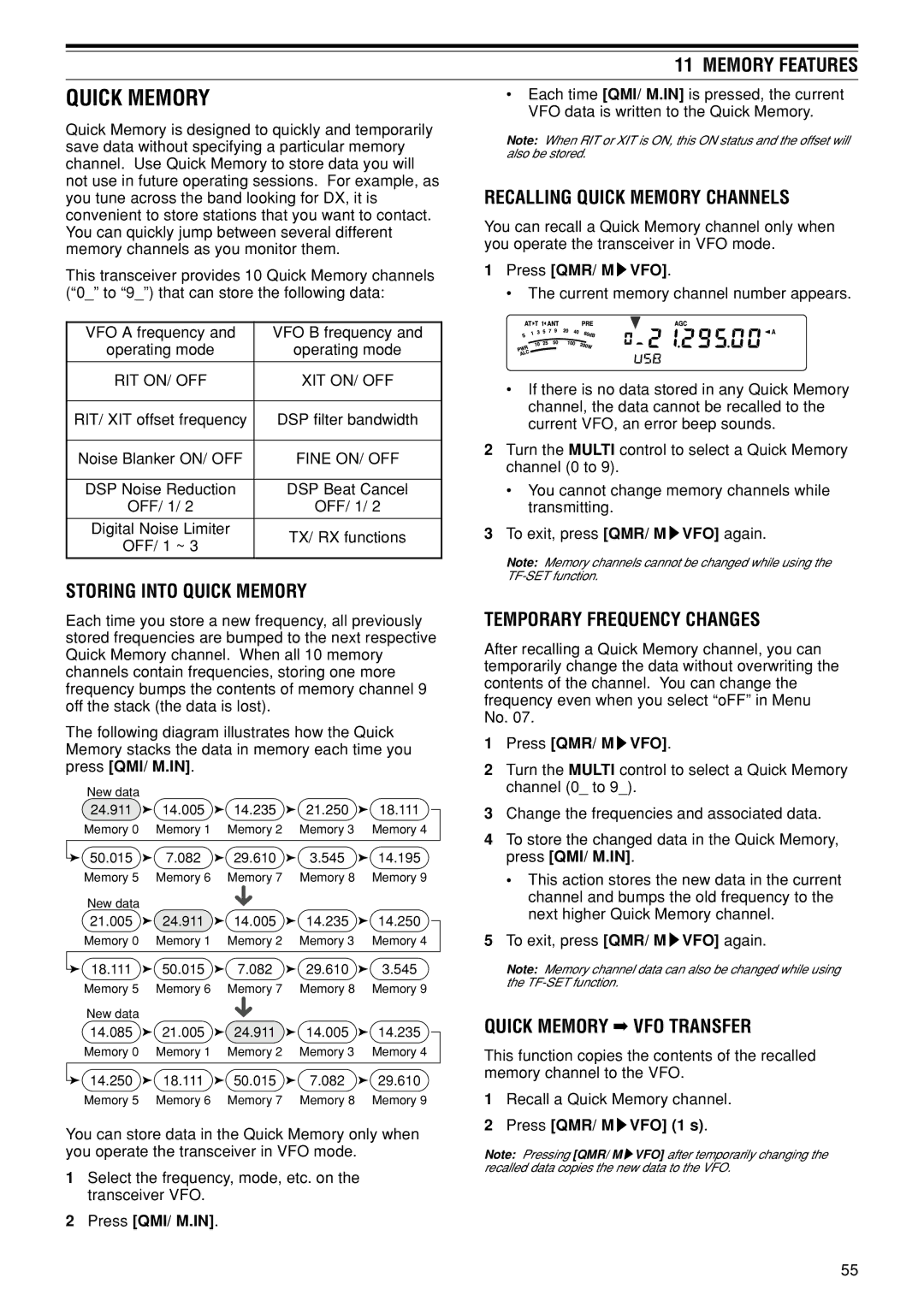
11 MEMORY FEATURES
QUICK MEMORY
Quick Memory is designed to quickly and temporarily save data without specifying a particular memory channel. Use Quick Memory to store data you will not use in future operating sessions. For example, as you tune across the band looking for DX, it is convenient to store stations that you want to contact. You can quickly jump between several different memory channels as you monitor them.
This transceiver provides 10 Quick Memory channels (“0_” to “9_”) that can store the following data:
VFO A frequency and | VFO B frequency and | |
operating mode | operating mode | |
|
| |
RIT ON/ OFF | XIT ON/ OFF | |
|
| |
RIT/ XIT offset frequency | DSP filter bandwidth | |
|
| |
Noise Blanker ON/ OFF | FINE ON/ OFF | |
|
| |
DSP Noise Reduction | DSP Beat Cancel | |
OFF/ 1/ 2 | OFF/ 1/ 2 | |
|
| |
Digital Noise Limiter | TX/ RX functions | |
OFF/ 1 ~ 3 | ||
| ||
|
|
STORING INTO QUICK MEMORY
Each time you store a new frequency, all previously stored frequencies are bumped to the next respective Quick Memory channel. When all 10 memory channels contain frequencies, storing one more frequency bumps the contents of memory channel 9 off the stack (the data is lost).
The following diagram illustrates how the Quick Memory stacks the data in memory each time you press [QMI/ M.IN].
New data |
|
|
|
|
24.911 | 14.005 | 14.235 | 21.250 | 18.111 |
Memory 0 | Memory 1 | Memory 2 | Memory 3 | Memory 4 |
50.015 | 7.082 | 29.610 | 3.545 | 14.195 |
Memory 5 | Memory 6 | Memory 7 | Memory 8 | Memory 9 |
New data |
|
|
|
|
21.005 | 24.911 | 14.005 | 14.235 | 14.250 |
Memory 0 | Memory 1 | Memory 2 | Memory 3 | Memory 4 |
18.111 | 50.015 | 7.082 | 29.610 | 3.545 |
Memory 5 | Memory 6 | Memory 7 | Memory 8 | Memory 9 |
New data |
|
|
|
|
14.085 | 21.005 | 24.911 | 14.005 | 14.235 |
Memory 0 | Memory 1 | Memory 2 | Memory 3 | Memory 4 |
14.250 | 18.111 | 50.015 | 7.082 | 29.610 |
Memory 5 | Memory 6 | Memory 7 | Memory 8 | Memory 9 |
You can store data in the Quick Memory only when you operate the transceiver in VFO mode.
1Select the frequency, mode, etc. on the transceiver VFO.
2Press [QMI/ M.IN].
•Each time [QMI/ M.IN] is pressed, the current VFO data is written to the Quick Memory.
Note: When RIT or XIT is ON, this ON status and the offset will also be stored.
RECALLING QUICK MEMORY CHANNELS
You can recall a Quick Memory channel only when you operate the transceiver in VFO mode.
1Press [QMR/ MsVFO].
•The current memory channel number appears.
•If there is no data stored in any Quick Memory channel, the data cannot be recalled to the current VFO, an error beep sounds.
2Turn the MULTI control to select a Quick Memory channel (0 to 9).
•You cannot change memory channels while transmitting.
3To exit, press [QMR/ MsVFO] again.
Note: Memory channels cannot be changed while using the
TEMPORARY FREQUENCY CHANGES
After recalling a Quick Memory channel, you can temporarily change the data without overwriting the contents of the channel. You can change the frequency even when you select “oFF” in Menu No. 07.
1Press [QMR/ MsVFO].
2Turn the MULTI control to select a Quick Memory channel (0_ to 9_).
3Change the frequencies and associated data.
4To store the changed data in the Quick Memory, press [QMI/ M.IN].
•This action stores the new data in the current channel and bumps the old frequency to the next higher Quick Memory channel.
5To exit, press [QMR/ MsVFO] again.
Note: Memory channel data can also be changed while using the
QUICK MEMORY ➡ VFO TRANSFER
This function copies the contents of the recalled memory channel to the VFO.
1Recall a Quick Memory channel.
2Press [QMR/ MsVFO] (1 s).
Note: Pressing [QMR/ MsVFO] after temporarily changing the recalled data copies the new data to the VFO.
55
